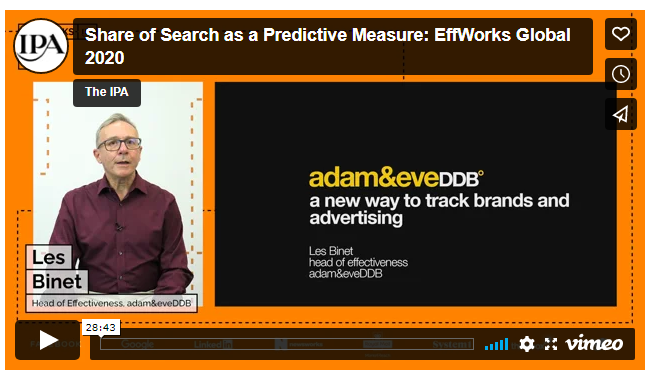C-suites everywhere are looking to marketing to be aligned with overall C-suite goals. They are, in essence, looking for marketing to both sign up to help deliver on major company goals and to be able to explain marketing’s contribution to overall company success.
A sound starting point is for the CMO, marketing staff and agencies to have a clear (and supportable) framework for how marketing impacts customer behaviors in a manner that drives the business. How can you build a model that helps guide marketing and tracking activities? The starting point is a data-driven knowledge base of how the customer journey in your industry works. Marketing Mix Modeling (MMM) and Multi-Touch Attribution (MTA) are powerful sciences that can contribute to a company’s knowledge base regarding what is working (and what is not) in its marketing efforts. But they have severe drawbacks including cost, the need for robust data and their inherent backward-looking nature.
What can a firm that lacks the resources for MMM or MTA do, or how can a firm supplement these sciences in a more timely manner? For many firms, Share of Search can be a powerful and inexpensive tool.
In this post I liberally pulled from the writings of marketing strategy stars like Les Binet, James Hankins and others. A list of references follows later in the article.
What “Share of Search” is & why it’s important
Let’s start with a quick, commonly accepted definition in the rapidly developing science of “Share of Search”:
Share of Search is the percentage of organic searches in any given competitive set that are for your brand/product.
Why is it important? Les Binet’s work has shown that Share of Search is a powerful and reliable proxy for consumer-led demand. In Les Binet’s work he’s found that It can be used as a proxy for measuring demand as there is a strong correlation between SoS and consumer mental availability.

See Les Binet’s IPA presentation here.
But wait, there’s more…
Share of Search (SoS) is also a Proxy for Market Share (SoM)
It turns out that there is an 83% correlation coefficient between SoS and SoM (Share of Market) as measured across…
- 30 Case Studies*
- 12 Categories
- 7 countries
- 3 languages
*Most measured using Share of Value, but some studies used Share of Volume.
Share of Search can also serve as the Canary in the Coal Mine
Share of Search can predict changes in market share up to one year in advance. The lead time depends on the category, but this holds true for both FMCGs and planned purchases. Car brands, for instance, had an average lead time of one year. Phones had a lead time of up to 6 months.

This correlative relationship is statistically significant for most brands but is even stronger for economy and midscale brands (i.e., most brands!). This finding is rather intuitive, as (for example) a vast majority of those who search for “Ferrari” do not eventually buy one.
Why Share of Search is So Important
Just a starter list of reasons why Share of Search can be so important include:
- Not everyone has access to market share data and it can be costly. Google Trends is free to use.
- It works across industries and sizes of business.
- It can work for small sample sizes as well. The IPA gives an example of SoS predicting changes in SoM for a Swedish ice cream brand that only averaged 196 searches/month.
- Share of Search could also be a new measure for brand strength/health by measuring the base level of Share of Search without advertising.
- SoS also has a positive correlation with mental availability (as measured through questionnaires) without many of the typical challenges of consumer research:
- Bias from respondents forced to respond
- Low survey response rates
- Overall category growth/decline
- Seasonal fluctuations
As David Ogilvy once said: “The trouble with research is that people don’t always do what they say, don’t say what they think, and don’t think how they feel.”
Some Practical Guidance
Our recommendation at Mercer Island Group is that you read up on Share of Search and review the available videos and conference reports before you start. We’ve listed a number of great sources at the end of this post.
In addition, a few quick starting notions from our reading to-date include:
- The research on this metric has been used measuring data from Google Trends. So, marketers must have a strong understanding of who their competitors are, as these must be manually entered into GT.
- The calculation is pretty straightforward:
- For all brands, but especially small brands: looking at a six-month or year-long moving average is recommended to reduce noise and smooth out outliers.
- When a brand’s SoS > SoM, its Excess SoS is positive. When a brand’s SoS is less than its SoM, it can be said to have a negative Excess SoS.
Brands with positive Excess SoS usually see their market share grow in following years, whereas market share for brands with Excess SoS < 0 typically declines.
This forecasting method is also relative. The higher a brand’s Excess SoS, the higher its market share can be expected to grow. The reverse is also true.
Share of Search is an Important Innovation for Marketers & Agency Execs
Share of Search is an extremely simple and easy-to-understand concept tailor made for businesses of any size and for executives from all walks of life from marketers to agency execs to CFOs. This is a critical and reliable business metric that marketers and agency execs can use to prove they’ve added value.
We amply leveraged the work of the following sources and we encourage you to read their key writings:
- Binet, adam&eveDDB, “Share of Search as a Brand Metric”
- Pozo & Pirenne, “Share of Search Webinar: How to use Share of Search as a strategic metric”
- Marketing Week, “Share of search represents 83% of a brand’s market share, think tank finds”, link: https://www.marketingweek.com/share-of-search-market-share/
- Binet, adam&eveDDB, “Share of Search as a Brand Metric”
- ChannelSight Blog Post, link: https://www.channelsight.com/blog/share-of-search
- Hankins, WARC, “The Most Important Metric You’ve Never Heard of”
- Cripps & Hankins, THE POWER OF SEARCH AS A SIGNAL — AND ALTERNATIVE CURRENCY — FOR ADVERTISERS – PDF here and video here
- Binet, “A New Way to Track Consumer Demand”, EFFWORKS GLOBAL 2020 IPA
Steve Boehler, founder, and partner at Mercer Island Group has led consulting teams on behalf of clients as diverse as Zillow Group, Microsoft, UScellular, Nintendo, Ulta Beauty, Stop & Shop, Qualcomm, Brooks Running, and numerous others. He founded MIG after serving as a division president in a Fortune 100 when he was only 32. Earlier in his career, Steve cut his teeth with a decade in Brand Management at Procter & Gamble, leading brands like Tide, Pringles, and Jif.
